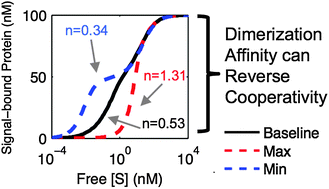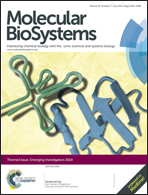Dimerization-based control of cooperativity†
Abstract
Cooperativity of ligand–receptor binding influences the input–output behavior of a biochemical system and thus is an important determinant of its physiological function. Canonically, such cooperativity is understood in terms of ligand–receptor binding affinity, where an initial binding event changes the affinity for subsequent binding events. Here, we demonstrate that dimerization—a simple yet pervasive signaling motif across biology—can have significant control over cooperativity and even dominate over the canonical mechanism. Through an exhaustive parameter sensitivity analysis of a general kinetic model for signal-mediated dimerization, we show that quantitative modulation of dimerization processes can reinforce, eliminate, and even reverse cooperativity imposed by the canonical allosteric ligand–receptor binding affinity mechanism. The favored accumulation of stoichiometrically asymmetric dimers (those with ligand–receptor stoichiometry of 1 : 2) is a major determinant of dimerization-based cooperativity control. However, simulations demonstrate that favoring accumulation of such stoichiometrically asymmetric dimers can either increase or decrease cooperativity, and thus the quantitative relationship between stoichiometrically asymmetric dimers and cooperativity is highly dependent on the parameter values of the particular system of interest. These results suggest that the dimerization motif provides a novel mechanism for both generating and quantitatively tuning cooperativity that, due to the ubiquity of dimerization motifs in biochemical systems, may play a major role in a host of biological functions. Thus, the canonical, allosteric view of cooperativity is incomplete without considering dimerization effects, which is of particular importance as dimerization is often a necessary feature of the allosteric mechanism.


 Please wait while we load your content...
Please wait while we load your content...